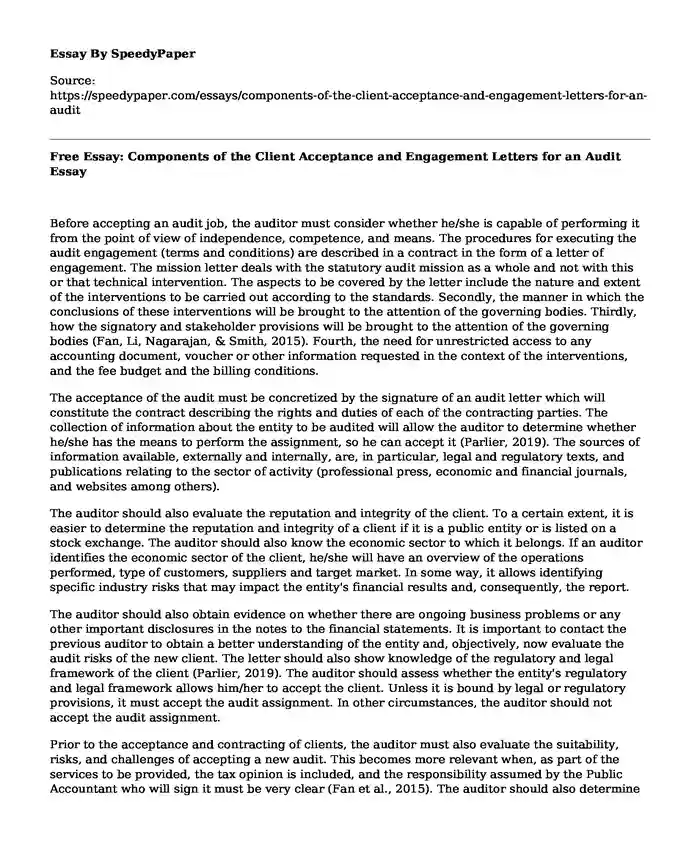
| Type of paper: | Course work |
| Categories: | Audit Accounting Business management Customer service |
| Pages: | 3 |
| Wordcount: | 762 words |
Before accepting an audit job, the auditor must consider whether he/she is capable of performing it from the point of view of independence, competence, and means. The procedures for executing the audit engagement (terms and conditions) are described in a contract in the form of a letter of engagement. The mission letter deals with the statutory audit mission as a whole and not with this or that technical intervention. The aspects to be covered by the letter include the nature and extent of the interventions to be carried out according to the standards. Secondly, the manner in which the conclusions of these interventions will be brought to the attention of the governing bodies. Thirdly, how the signatory and stakeholder provisions will be brought to the attention of the governing bodies (Fan, Li, Nagarajan, & Smith, 2015). Fourth, the need for unrestricted access to any accounting document, voucher or other information requested in the context of the interventions, and the fee budget and the billing conditions.
The acceptance of the audit must be concretized by the signature of an audit letter which will constitute the contract describing the rights and duties of each of the contracting parties. The collection of information about the entity to be audited will allow the auditor to determine whether he/she has the means to perform the assignment, so he can accept it (Parlier, 2019). The sources of information available, externally and internally, are, in particular, legal and regulatory texts, and publications relating to the sector of activity (professional press, economic and financial journals, and websites among others).
The auditor should also evaluate the reputation and integrity of the client. To a certain extent, it is easier to determine the reputation and integrity of a client if it is a public entity or is listed on a stock exchange. The auditor should also know the economic sector to which it belongs. If an auditor identifies the economic sector of the client, he/she will have an overview of the operations performed, type of customers, suppliers and target market. In some way, it allows identifying specific industry risks that may impact the entity's financial results and, consequently, the report.
The auditor should also obtain evidence on whether there are ongoing business problems or any other important disclosures in the notes to the financial statements. It is important to contact the previous auditor to obtain a better understanding of the entity and, objectively, now evaluate the audit risks of the new client. The letter should also show knowledge of the regulatory and legal framework of the client (Parlier, 2019). The auditor should assess whether the entity's regulatory and legal framework allows him/her to accept the client. Unless it is bound by legal or regulatory provisions, it must accept the audit assignment. In other circumstances, the auditor should not accept the audit assignment.
Prior to the acceptance and contracting of clients, the auditor must also evaluate the suitability, risks, and challenges of accepting a new audit. This becomes more relevant when, as part of the services to be provided, the tax opinion is included, and the responsibility assumed by the Public Accountant who will sign it must be very clear (Fan et al., 2015). The auditor should also determine whether the application of the financial information framework is appropriate and allows users to comprehend the information presented in the financial statement and its element and also determine if the form of the opinion is appropriate to the circumstances.
The auditor must choose the method most suited to the nature of his/her mission. He/she begins his work with a preliminary phase that will allow him/her to acquire a general knowledge of the company and its environment in order to identify the risks specific to this company and to identify the systems and the significant domains, which will make it possible to determine the elements on which the auditor will concentrate his/her work. Other conditions necessary for the acceptance of the audit include global awareness of the company, appreciation of the independence and absence of incompatibilities, and examination of the available competence for the type of company concerned.
References
Fan, Y., Li, C., Nagarajan, N., & Smith, J. (2015). Auditor litigation, audit office pricing and client acceptance. Working paper, University of Pittsburgh, Texas A &M University and 2015 Mid-year Auditing Conference.
Parlier, J. A. (2019). The Client Acceptance and Retention Process: How Policies and Procedures Are Developed and Implemented within Audit Firms (Doctoral dissertation, Virginia Tech). Retrieved from https://vtechworks.lib.vt.edu/bitstream/handle/10919/90369/Parlier_JA_D_2019.pdf?sequence=1&isAllowed=y
Cite this page
Free Essay: Components of the Client Acceptance and Engagement Letters for an Audit. (2023, Feb 23). Retrieved from https://speedypaper.com/essays/components-of-the-client-acceptance-and-engagement-letters-for-an-audit
Request Removal
If you are the original author of this essay and no longer wish to have it published on the SpeedyPaper website, please click below to request its removal:
- Essay Sample on Eric's Treatment Recommendations
- Compare and Contrast Essay Sample: The X-box One and Play Station 4
- Essay Sample: Methods to Fight the Jim Crow Laws
- Rise of Opioid Addiction, Free Essay for Everyone
- Free essay sample: The American Music
- Internationalization of Curriculum Essay Sample
- Business Ethics - Free Essay Sample
Popular categories




